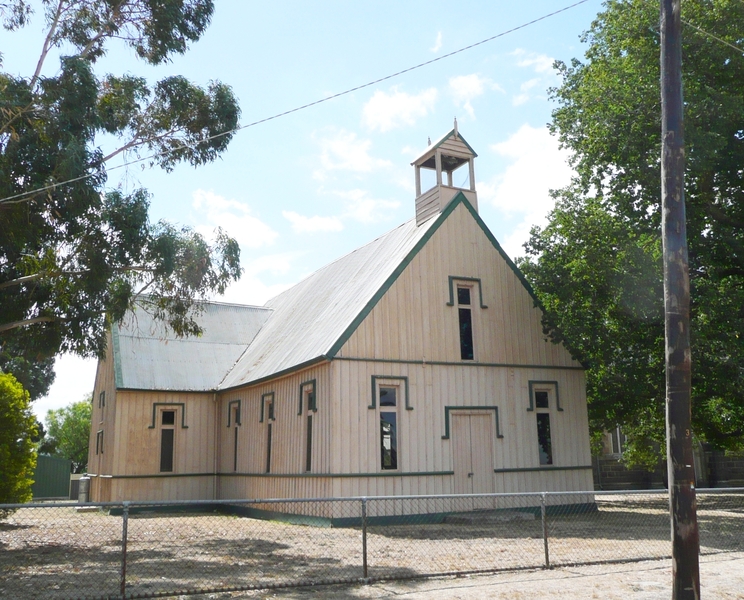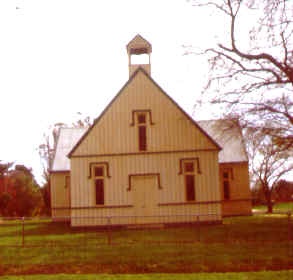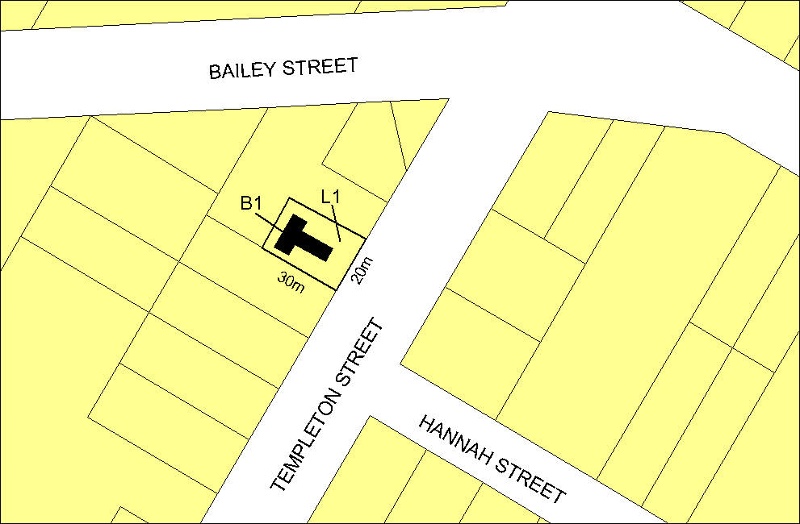FORMER ST PAULS CHURCH OF ENGLAND
10 TEMPLETON STREET CLUNES, HEPBURN SHIRE
-
Add to tour
You must log in to do that.
-
Share
-
Shortlist place
You must log in to do that.
- Download report




Statement of Significance
This timber, possibly pre-fabricated, church was first erected in Clunes for the congregation of St Pauls Anglican Church between 1859-60 on a different site (Fraser Street) from where it is now located and with just a single nave. A photograph taken in about 1863 shows the building as a simple rectangle with no transept, no bell cote and five windows along each side. In 1869 the timber church was moved to the present site in Templeton Street and the original site in Fraser Street was sold. By December 1870 the foundation stone had been laid for a new stone Church of England which was opened in August 1871. The original timber church was then used as a Sunday School, and later as a church hall. Clunes was one of the first gold mining towns established in Victoria. Although the alluvial gold was depleted early, Clunes experienced something of a hey-day between 1861 and 1881 when its deep lead was being plumbed by a company which claimed to have one of the most efficient mining and extracting plants in the colony.
How Significant?
St Pauls Anglican Church Hall is architecturally and historically significant to the State of Victoria.
Why significant?
St Pauls Anglican Church Hall is architecturally significant as a rare example of an 1850s (possibly prefabricated) timber church. It is important as the only example of the use of vertical boards more commonly used in New Zealand and North America. The interior retains stencilled decorations, possibly added in about 1870-80, which are also important in demonstrating early decorative patterns.
St Pauls Anglican Church Hall is important for its associations with the Clunes goldfield, one of the earliest developed in the State, but more particularly with its later development as a more settled 'company' town. It is historically significant for its ability to demonstrate social and cultural associations related to the importance of religion and early settlement patterns on Victoria's nineteenth century goldfields where the churches offered more than a spiritual message, they were social centres in a land where other social institutions were weak.
-
-
FORMER ST PAULS CHURCH OF ENGLAND - History
In 1851 gold was discovered in the newly-declared Colony of Victoria, significantly altering settlement patterns. It was difficult providing the infrastructure for towns which popped up overnight in remote parts of the colony, particularly as the population could disappear equally as quickly in search of gold at a newly discovered field. Portable, or prefabricated, buildings provided one solution to the problem, especially in areas where no infrastructure had developed to support a building industry. They were bought from England, the United States, sometimes via South Africa and New Zealand.
Clunes was one of the first gold mining towns established in Victoria. Although the alluvial gold was depleted early, Clunes experienced something of a hey-day between 1861 and 1881 when its deep lead was being plumbed by a company which claimed to have one of the most efficient mining and extracting plants in the colony.
With the weakening of the gold rush and greater reliance on deep lead mining, people began to settle down and establish social infrastructures. The demographic dominance of men declined; the mania for gold waned; people ceased to rush from one gold field to another, and the churches gained. The churches offered more than a spiritual message: they were social centres in a land where other social institutions were weak.
History of Place:
A timber church was erected in Clunes for the congregation of St Pauls Anglican Church between 1859-60. It was erected on a different site from where now located, in Fraser Street, and with just a single nave. A photograph taken in about 1863 shows the building as a simple rectangle with no transept, no bell cote and five windows along each side. A wood engraving from the Illustrated Australian News, published in 1869, shows the church with the transepts added and a cross mounted on top of the gable. The artist has also shown the building projecting beyond the transept - this does not occur in the present structure and may have only been an inaccuracy on the part of the artist.
The congregation of St Pauls must have increased in number, and prospered. Within only eight years of the erection of the timber church, plans were being made to acquire a larger block of land and to construct a stone church. In 1869 the timber church was moved to the present site in Templeton Street and the original site in Fraser Street was sold. By December 1870 the foundation stone had been laid for a new stone Church of England which was opened in August 1871.
The original timber church was then used as a Sunday School, and later as a church hall.
Associated People:
FORMER ST PAULS CHURCH OF ENGLAND - Assessment Against Criteria
Criterion A
The historical importance, association with or relationship to Victoria's history of the place or object.
St Paul's Church Clunes is important in demonstrating religious practises on the gold fields
Criterion B
The importance of a place or object in demonstrating rarity or uniqueness.
St Paul's is a rare example of an 1850s timber church, and is the only example of the use of vertical boards more commonly used in New Zealand and North America.
Criterion C
The place or object's potential to educate, illustrate or provide further scientific investigation in relation to Victoria's cultural heritage.
N/A
Criterion D
The importance of a place or object in exhibiting the principal characteristics or the representative nature of a place or object as part of a class or type of places or objects.
N/A
Criterion E
The importance of the place or object in exhibiting good design or aesthetic characteristics and/or in exhibiting a richness, diversity or unusual integration of features.
The interior of the former St Paul's Church Clunes (now hall) retains stencilled decorations, possibly added in about 1870-80, which provides an example of the simple decorative patterns applied in the second half of the nineteenth century.
Criterion F
The importance of the place or object in demonstrating or being associated with scientific or technical innovations or achievements.
N/A
Criterion G
The importance of the place or object in demonstrating social or cultural associations.
The former St Paul's Church (now hall) is historically significant for its ability to demonstrate social and cultural associations related to the early phase of Victoria's development.
Criterion H
Any other matter which the Council considers relevant to the determination of cultural heritage significance
N/AFORMER ST PAULS CHURCH OF ENGLAND - Permit Exemptions
General Exemptions:General exemptions apply to all places and objects included in the Victorian Heritage Register (VHR). General exemptions have been designed to allow everyday activities, maintenance and changes to your property, which don’t harm its cultural heritage significance, to proceed without the need to obtain approvals under the Heritage Act 2017.Places of worship: In some circumstances, you can alter a place of worship to accommodate religious practices without a permit, but you must notify the Executive Director of Heritage Victoria before you start the works or activities at least 20 business days before the works or activities are to commence.Subdivision/consolidation: Permit exemptions exist for some subdivisions and consolidations. If the subdivision or consolidation is in accordance with a planning permit granted under Part 4 of the Planning and Environment Act 1987 and the application for the planning permit was referred to the Executive Director of Heritage Victoria as a determining referral authority, a permit is not required.Specific exemptions may also apply to your registered place or object. If applicable, these are listed below. Specific exemptions are tailored to the conservation and management needs of an individual registered place or object and set out works and activities that are exempt from the requirements of a permit. Specific exemptions prevail if they conflict with general exemptions. Find out more about heritage permit exemptions here.Specific Exemptions:General Conditions:
1. All exempted alterations are to be planned and carried out in a manner which prevents damage to the fabric of the registered place or object.
2. Should it become apparent during further inspection or the carrying out of alterations that original or previously hidden or inaccessible details of the place or object are revealed which relate to the significance of the place or object, then the exemption covering such alteration shall cease and the Executive Director shall be notified as soon as possible.
3. If there is a conservation policy and plan approved by the Executive Director, all works shall be in accordance with it.
4. Nothing in this declaration prevents the Executive Director from amending or rescinding all or any of the permit exemptions.
5. Nothing in this declaration exempts owners or their agents from the responsibility to seek relevant planning or building permits from the responsible authority where applicable.
* Electrical rewiring provided that original decorative features are not damaged.
* Repainting of previously painted surfaces provided that preparation or painting does not destroy evidence of earlier decorative schemes.FORMER ST PAULS CHURCH OF ENGLAND - Permit Exemption Policy
The importance of the building lies in its age, its design and its original constructional materials and finishes. All works should be undertaken so that original materials are preserved as long as possible and the design remains unchanged. Repairs should match original work in every detail and where ever possible retain the original material rather than replace it. Wholesale removal of original material should be avoided.
-
-
-
-
-
CLUNES POST OFFICE
 Victorian Heritage Register H0601
Victorian Heritage Register H0601 -
CLUB HOTEL
 Victorian Heritage Register H0341
Victorian Heritage Register H0341 -
FORMER ES&A BANK (CLUNES)
 Victorian Heritage Register H0340
Victorian Heritage Register H0340
-
'CARINYA' LADSONS STORE
 Victorian Heritage Register H0568
Victorian Heritage Register H0568 -
1 Alexander Street
 Yarra City
Yarra City -
1 Botherambo Street
 Yarra City
Yarra City
-
-












